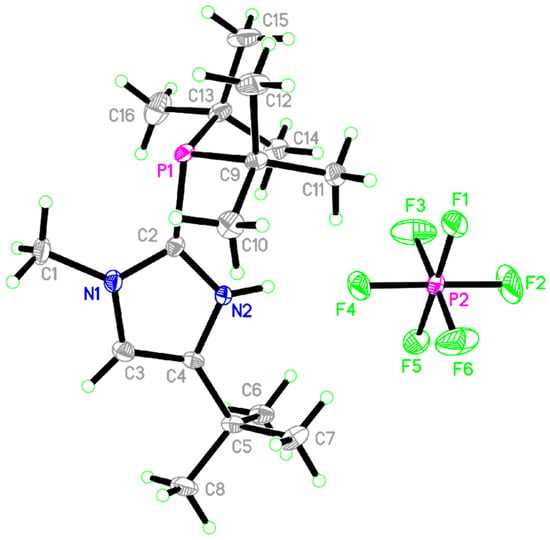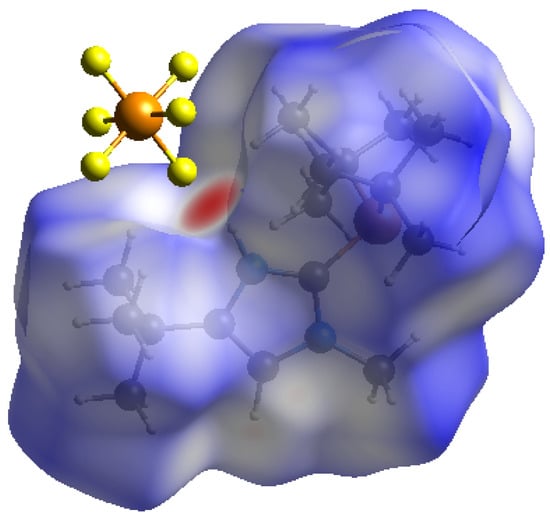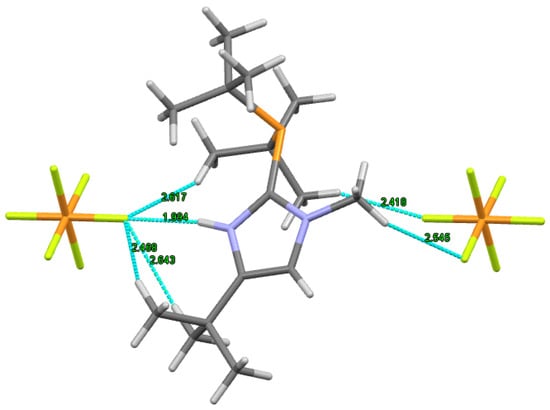Abstract
In the field of homogeneous catalysis, particularly in anti-Markovnikov hydration, sterically demanding phosphine ligand has found to be very effective. Here we report the crystal structure of a phosphine-imidazolium salt which crystallized in monoclinic space group P21/c with a = 16.6623(13) (Å), b = 10.6686(8) (Å) and c = 12.8916(11) with β = 110.232(2). Hirshfeld surface analysis show that the halogen–hydrogen interaction leads to a formation of 1D chain.
1. Introduction
Sterically demanding phosphine ligands have found their application in homogeneous catalysis. A particular group of phosphine ligands bearing imidazolyl moieties provides transition metal complexes based on them with a unique set of reactivities. In 2001, a ruthenium complex with two phosphines Ph2PIm (where Im = 4-tert-butyl-1-methylimidazol-2-yl) was reported to catalyze the anti-Markovnikov hydration of terminal alkynes [1], while a ruthenium complex with chelating ligand iPr2PIm exhibited remarkable activity in reactions of alkene isomerization and deuteration [2,3]. The latter’s more sterically demanding analog, tBu2PIm, was used in a study of Pd(0) and Pd(II) complexes, where its significant steric bulkiness was shown to enforce chelation [4]. The same ligand was also recently utilized in a systematic study of terminal alkenes isomerization catalyzed by Ru-based complexes containing cyclopentadienyl rings with different degrees of methylation [5], as well as in a work on site-selective deuteration of polyalkenes [6]. Here we report the synthesis and X-ray crystal structure of this ligand’s protonated form—the phosphine-imidazolium salt [tBu2PImH] PF6 (1).
2. Results
Protonation of bis-(tert-butyl) (4- tert-butyl-1-methylimidazol-2-yl) phosphine in the presence of HCl followed by the anion replacement with KPF6 leads to theaa formation of rather air and moisture stable protonated phosphine- imidazolium salt [tBu2PImH]PF6. Slow evaporation of an acetone solution of [tBu2PImH] PF6 leads to the formation of colorless block of single crystals. The resulting molecular structure is shown in Figure 1 and selected bond lengths and angles are given in Table 1 (details in supplementary, CCDC 2003050). A search of the Cambridge Structural Database (Version 2.0.5, last update March 2020) does not reveal any similar phosphine structures. Crystal parameters of closely related protonated Imidazole ligands [7] are similar to the reported crystal structure in this study.

Figure 1.
ORTEP diagram of complex 1 with thermal ellipsoids drawn at the 50% probability level.

Table 1.
Selected bond parameters of complex 1.
Hirschfeld Surface Analysis
A Hirshfeld surface analysis was performed using Crystal Explorer [8]. The Hirshfeld surface mapped using an iso value of 0.5, with red contours indicating a contact less than the sum of the Van Der Waals radii of the respective elements, while blue and while contours indicate that the nearest external atom is at a distance greater than or equal to the sum of the Van Der Waals radii, respectively from the atomic coordinate as shown in Figure 2.

Figure 2.
Hirshfeld surface analysis of complex 1 (red contours indicating close contacts).
The Hirshfeld analysis of 1 reveals an array of halogen–hydrogen interactions [9] involving the F atoms, ranging from liner Type 1 [10] short N-H⋯F contact between H2 and the F4 from the PF6 anion group (1.994 Å) to a rather weak bent Type 2 [10] C-H⋯F contact between H7A and the F4 (2.643 Å) as shown in Figure 3. The dominating stronger Type 1 halogen–hydrogen interactions lead to the formation of 1D chain along b-axis as shown in Figure 4.

Figure 3.
An array of weak and strong halogen–hydrogen interactions involving the PF6 anion in complex 1.

Figure 4.
Halogen–hydrogen interaction (seen along the c-axis) leading to 1-D chain along b-axis.
3. Materials and Methods
All experiments were performed under dry nitrogen atmosphere using standard Schlenk techniques. Diethyl ether was distilled from sodium/benzophenone and stored over 4 Ǻ molecular sieves. Acetone was dried using B2O3 as a drying agent. Anhydrous DCM was transferred to and stored over 4 Ǻ molecular sieves. Dried solvents were degassed by means of reduced pressure. tBu2PIm was prepared according to method described in literature [4]. NMR spectra were recorded at 25 °C on JEOL ECA 400 spectrometer (400 MHz listed below for 1H = 399.763 MHz, 100 MHz for 13C{1H} = 100.525 MHz and 161 MHz for 31P = 161.922 MHz). 1H NMR chemical shifts are reported in parts per million to low field relative to tetramethylsilane and referenced to residual solvent resonances. 31P{1H} NMR chemical shifts were referenced to an external 85% aqueous H3PO4 capillary placed in the solvent. NMR signals are listed in low to high field order followed by peak multiplicity, coupling constants J in Hertz and peak integration in parentheses.
Synthesis of Phosphine-Imidazolium Salt [tBu2PImH]PF6
A stock solution of tBu2PIm (2 mL, 0.22 M in acetone, 0.44 mmol) was transferred into a 50-mL Schlenk flask and all volatiles were removed in vacuo. The phosphine was redissolved in 5 mL of diethyl ether and HCl solution (0.11 mL, 4 M in dioxane, 0.44 mmol) was added. The mixture was allowed to stir for 1 h after which the white precipitate was isolated by filtration, washed with ether and dried under reduced pressure. Five milliliters DCM was added to the flask followed by the suspension of KPF6 in 5 mL DCM. The mixture was left stirring overnight, after which DCM was removed in vacuo. Extraction with acetone (two 3-mL portions) and removal of all volatiles under reduced pressure afforded the compound [tBu2PImH]PF6 as fine white powder, 168 mg (89%). 1H NMR (400 MHz, acetone-d6) δ 12.02 (br s, 1H), 7.75 (s, 1H), 4.20 (s, 3H), 1.46 (s, 9H), 1.34 (s, 9H), 1.31 (s, 9H) ppm. 13C{1H} NMR (100 MHz, acetone-d6) δ 145.9 (d, J = 2.3), 145.4 (d, J = 63.5), 145.1 (s), 37.02 (d, J = 20.1), 33.5 (d, J = 20.1), 31.0 (s), 29.4 (s), 28.2 (s) ppm. 31P{1H} NMR (161 MHz, acetone-d6) δ 10.9 (s), −143.6 (sept, 1JPF = 709 Hz) ppm. Elemental Anal. (Perkin Elmer PE 2400 II CHONS): calcd for C16H32F6N2P2: C, 44.86; H, 7.53; N, 6.54; Found: C, 44.98; H, 7.53; N, 6.55.
Supplementary Materials
CCDC 2003050 contains the supplementary crystallographic data for compound 1. These data can be obtained free of charge via http://www.ccdc.cam.ac.uk/conts/retrieving.html or from the Cambridge Crystallographic Data Center, 12 Union Road, Cambridge CB2 1EZ, UK; fax: +44 1223-336-033; or e- mail: deposit@ ccdc.cam.ac.uk.
Author Contributions
A.V.S. prepared the compound; V.J. designed the experiments, R.G. collected and analyzed the X-ray data and wrote the study. All authors have read and agreed to the published version of the manuscript.
Funding
This research received no external funding.
Acknowledgments
The authors acknowledge the help for Drasko V, Monash University for some of the discussions.
Conflicts of Interest
The authors declare no conflict of interest.
References
- Grotjahn, D.B.; Incarvito, C.D.; Rheingold, A.L. Combined effects of metal and ligand capable of accepting a proton or hydrogen bond catalyze anti-Markovnikov hydration of terminal alkynes. Angew. Chem. Int. Ed. 2001, 40, 3884–3887. [Google Scholar] [CrossRef]
- Grotjahn, D.B.; Larsen, C.R.; Gustafson, J.L.; Nair, R.; Sharma, A. Extensive isomerization of alkenes using a bifunctional catalyst: An alkene zipper. J. Am. Chem. Soc. 2007, 129, 9592–9593. [Google Scholar] [CrossRef] [PubMed]
- Erdogan, G.; Grotjahn, D.B. Mild and selective deuteration and isomerization of alkenes by a bifunctional catalyst and deuterium oxide. J. Am. Chem. Soc. 2009, 131, 10354–10355. [Google Scholar] [CrossRef] [PubMed]
- Grotjahn, D.B.; Gong, Y.; Zakharov, L.; Golen, J.A.; Rheingold, A.L. Changes in coordination of sterically demanding hybrid imidazolylphosphine ligands on Pd(0) and Pd(II). J. Am. Chem. Soc. 2006, 128, 438–453. [Google Scholar] [PubMed]
- Smarun, A.V.; Shahreel, W.; Pramono, S.; Koo, S.Y.; Tan, L.Y.; Ganguly, R.; Vidović, D. Influence of increasing steric demand on isomerization of terminal alkenes catalysed by bifunctional ruthenium complexes. J. Organomet. Chem. 2017, 834, 1–9. [Google Scholar] [CrossRef]
- Smarun, A.V.; Petković, M.; Shchepinov, M.S.; Vidović, D. Site-specific deuteration of polyunsaturated alkenes. J. Org. Chem. 2017, 82, 13115–13120. [Google Scholar] [CrossRef] [PubMed]
- Ge, Y.; Cui, X.-Y.; Tan, S.M.; Jiang, H.; Ren, J.; Lee, N.; Lee, R.; Tan, C.-H. Guanidine–Copper Complex Catalyzed Allylic Borylation for the Enantioconvergent Synthesis of Tertiary Cyclic Allylboronates. Angew. Chem. Int. Ed. Engl. 2019, 58, 2382–2383. [Google Scholar] [CrossRef] [PubMed]
- Turner, M.J.; McKinnon, J.J.; Wolff, S.K.; Grimwood, D.J.; Spackman, P.R.; Jayatilaka, D.; Spackman, M.A. CrystalExplorer17; University of Western Australia: Perth, Australia, 2017. [Google Scholar]
- Mukherjee, A.; Tothadi, S.; Desiraju, G.R. Halogen Bonds in Crystal Engineering: Like Hydrogen Bonds yet Different. Acc. Chem. Res. 2014, 47, 2514–2524. [Google Scholar] [CrossRef] [PubMed]
- Cavallo, G.; Metrangolo, P.; Milani, R.; Pilati, T.; Priimagi, A.; Resnati, G.; Terraneo, G. The Halogen Bond. Chem. Rev. 2016, 116, 2478–2601. [Google Scholar] [CrossRef] [PubMed]
© 2020 by the authors. Licensee MDPI, Basel, Switzerland. This article is an open access article distributed under the terms and conditions of the Creative Commons Attribution (CC BY) license (http://creativecommons.org/licenses/by/4.0/).